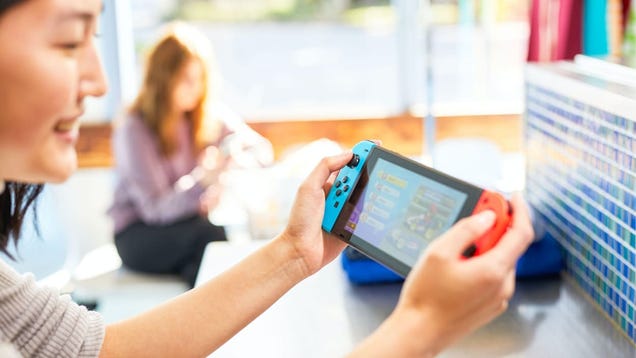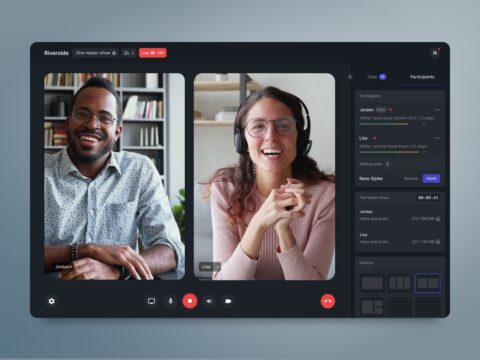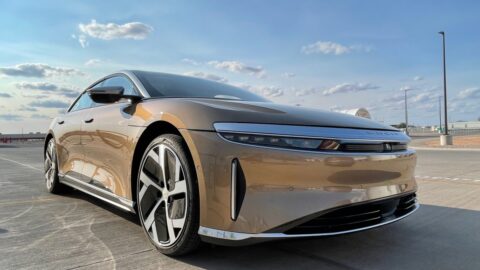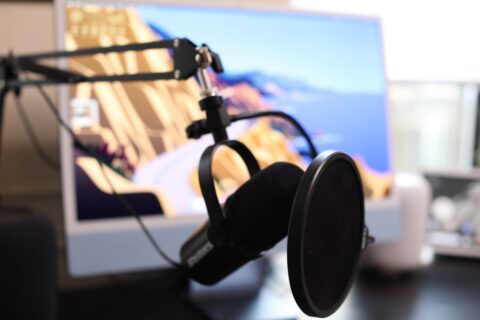If you’re among people as you read this, look to your left. Now look to your right. Statistically speaking, those on either side of you probably have their […]
New Horror Game Is ‘Too Crazy’ For Xbox Or Switch, But Not PS5

Christmas Massacre, an upcoming low-poly horror game, was initially planned to launch on Switch, Xbox, and PlayStation later this month. However, a few weeks before launch, the developer behind the spooky game revealed that Xbox and Nintendo won’t let the game release on their respective platforms, and they’re…

Nintendo Disputes Switch 2 Rumors, Despite Credible Evidence

Rumors of a Nintendo Switch successor have been circulating all year, and reports of private demos for developers at this year’s Gamescom and Activision getting briefed on the device only fueled the fire. Despite this, Nintendo pinky swears it never actually showed its next console (known colloquially as the “Switch…

Lucid adopts Tesla’s charging standard
Lucid has reached an agreement that will give owners of its luxury EVs access to Tesla’s network of superchargers — following the path of Ford, GM and the […]
Mike Flanagan shares epic list of his favourite horror movies on Letterboxd
Horror showrunner Mike Flanagan has joined Letterboxd and shared a long list of his favourite horror movies.

Between The Fall of the House of Usher, The Midnight Club, The Haunting of Hill House, and many more, Mike Flanagan is quickly becoming one of horror’s household names.
But what horror movies does the man himself like what watching? On Sunday, the writer/director joined the film-focused social media platform Letterboxd, and his first port of call was drawing up some all-time favourite lists.
“Finally joined Letterboxd,” wrote Flanagan on Twitter/X. “Only positing positivity, and it’s going to take me a few weeks to catch up on building my profile, but here’s a start.”
One of the lists contained a roundup of Mike Flanagan’s favourite horror movies of all-time. We’ve shared it below in full, ordered alphabetically:
-
The Addiction (1995)
-
An American Werewolf in London (1981)
-
The Beach House (2019)
-
The Blackcoat’s Daughter (2015)
-
The Blair Witch Project (1999)
-
The Blob (1988)
-
The Borderlands (2013)
-
Braindead (1992)
-
Bug (2006)
-
Candyman (1992)
-
Cargo (2017)
-
Carrie (1976)
-
Cat People (1942)
-
Censor (2021)
-
Creep (2014)
-
Creep 2 (2017)
-
Cronos (1992)
-
Cube (1997)
-
Cure (1997)
-
A Dark Song (2016)
-
Dawn of the Dead (1978)
-
The Dead Zone (1983)
-
The Deeper You Dig (2019)
-
The Descent (2005)
-
The Devil’s Backbone (2001)
-
Donnie Darko (2001)
-
Don’t Look Now (1973)
-
Drag Me To Hell (2009)
-
The Endless (2017)
-
Event Horizon (1997)
-
Evil Dead 2 (1987)
-
The Exorcist (1973)
-
The Exorcist III (1990)
-
The Eyes of My Mother (2016)
-
Flatliners (1990)
-
The Fog (1980)
-
Frailty (2001)
-
Fresh (2022)
-
Fright Night (1985)
-
Ghostwatch (1992)
-
A Girl Walks Home Alone at Night (2014)
-
Green Room (2015)
-
The Hallow (2015)
-
Halloween (1978)
-
The Haunting (1963)
-
Hellbender (2021)
-
The Hole in the Ground (2019)
-
The Host (2006)
-
The Innocents (1961)
-
In the Mouth of Madness (1994)
-
Invasion of the Body Snatchers (1978)
-
The Invitation (2015)
-
Jacob’s Ladder (1990)
-
Jaws (1975)
-
Ju-on: The Curse (2000)
-
Ju-on: The Curse 2 (2000)
-
Ju-on: The Grudge (2002)
-
Ju-on: The Grudge 2 (2003)
-
Kill List (2011)
-
Lake Mungo (2008)
-
Let the Right One In (2008)
-
The Lost Boys (1987)
-
Martyrs (2008)
-
Midsommar (2019)
-
Mimic (1997)
-
New Nightmare (1994)
-
Nightbreed (1990)
-
A Nightmare on Elm Street (1984)
-
A Nightmare on Elm Street 3: Dream Warriors (1987)
-
Night of the Living Dead (1968)
-
Nosferatu the Vampyre (1979)
-
The Omen (1976)
-
One Cut of the Dead (2017)
-
Only Lovers Left Alive (2013)
-
The Orphanage (2007)
-
The Others (2001)
-
The Outwaters (2022)
-
Paranormal Activity (2007)
-
Poltergeist (1982)
-
Pontypool (2008)
-
The Poughkeepsie Tapes (2007)
-
Predator (1987)
-
Primer (2004)
-
Resolution (2012)
-
The Return of the Living Dead (1985)
-
The Ritual (2017)
-
Saint Maud (2019)
-
The Shining (1980)
-
The Signal (2007)
-
The Sixth Sense (1999)
-
Something in the Dirt (2022)
-
Spring (2014)
-
The Taking of Deborah Logan (2014)
-
A Tale of Two Sisters (2003)
-
Tales From the Crypt: Demon Knight (1995)
-
Terrifier 2 (2022)
-
They Look Like People (2015)
-
The Thing (1982)
-
Thirst (2009)
-
Tigers Are Not Afraid (2017)
-
Train to Busan (2016)
-
Tremors (1990)
-
The Vast of Night (2019)
-
The Wailing (2016)
-
Watcher (2022)
-
Where the Devil Roams (2023)
-
The Woman in Black (1989)
-
You Won’t Be Alone (2022)
Flanagan has also shared lists of his favourite movies in general and his favourite independent horror movies. You can see all his lists on Letterboxd.
Apple 16-inch M3 Max MacBook Pro review: A desktop among laptops
This thing is a beast — in pretty much every sense. It’s a big, heavy, powerful system, with a bright display, massive battery life and impressive power under […]
Apple M3 iMac 24-inch review: More power, same package
A fun knock-on effect of this job is having to constantly switch between machines. The best way to test a product is integrating it into your daily routine […]
Is the green bean a fruit or a vegetable?
And why do we have such trouble classifying green beans?

Whether you love them or want to eradicate them from the Earth, you’ll probably see green beans on your Thanksgiving table this year.
And since you can’t avoid them, you may as well impress your relatives with this fun bean fact: the green bean is actually not a vegetable, but a fruit.
At least to a botanist, anyway.
“Fruits are structures that contain seeds,” Toby Adams, director of the Edible Academy at the New York Botanical Garden, said in an interview. “And a green bean is, basically, a pod that has seeds inside of it.”
Adams explained that the green bean is a “dry fruit,” which means that when it’s fully developed, the pod will dry out and crack open to reveal a mature seed. Then — fingers crossed — the seed will enter the earth, eventually germinating and growing more green beans. In fact, this is pretty much why the pod exists: to provide a vehicle for the seed’s dissemination.
The green beans we stir-fry and put into casseroles, though? Those are fruits that were picked immature, with the seed still sitting inside the pod. “But if you were in the garden and you … let those fruits fully develop,” Adams said, “the pod would eventually dry out.”

Credit: Shutterstock / azure
Then, you’d be left with a “shelf-stable” dried bean, freed of its papery pod and ready to be sold in bulk bins. But it’s unlikely that you’ll find mature green beans in bulk bins. Instead, they are made shelf-stable through canning.
The green beans we eat are immature, with the seeds still sitting inside the pod.
So beans are fruit. Cool, right? But what if, at the Thanksgiving table, your smartass cousin insists that the green bean can’t be a fruit because it’s a legume?
Please let them know that it’s both. The legume, in fact, is a type of dry fruit.
What, then, explains the pervasive myth that green beans are vegetables? Well, the terminology is all mixed up! In fact, the term “vegetable” isn’t really used by botanists at all. Instead, it’s used by grocers and others in the food industry, usually to identify produce that’s savory or used in savory recipes. (Culinary “fruits,” by contrast, are often sweet or used in sweet recipes.)
This strangely nebulous distinction has even had legal ramifications. In 1893, a fruit importer argued before the Supreme Court that tomatoes should be classified as fruits, not as vegetables as the Port Authority of New York had decreed. (The importer hoped to avoid the 10% tax imposed on imported vegetables at the time.)

Credit: Shutterstock / David Orcea
Now, tomatoes are fruits, botanically speaking. (In fact, they’re berries!) But in this case, the Supreme Court decided that tomatoes were still vegetables in a culinary sense — mostly because the terms “fruit” and “vegetable” didn’t have stable definitions in the world of commerce.
From the decision:
Botanically speaking, tomatoes are the fruit of a vine, just as are cucumbers, squashes, beans, and peas. But in the common language of the people, whether sellers or consumers of provisions, all these are vegetables which are grown in kitchen gardens, and which, whether eaten cooked or raw, are, like potatoes, carrots, parsnips, turnips, beets, cauliflower, cabbage, celery, and lettuce, usually served at dinner in, with, or after the soup, fish, or meats which constitute the principal part of the repast, and not, like fruits generally, as dessert.
This attitude prevails today. Tomatoes are still widely thought of as vegetables, despite being the poster children of the “actually, it’s a fruit” mini-movement. Same with zucchini, peppers, avocados and, of course, beans. The tariff in question is long gone, but the court case, Nix vs. Hedden, is still upheld today — and has, as Business Insider points out, affected numerous other cases involving taxation, classification, and the “common language” people use to refer to certain goods and services.
But you, reader, have received your botanist awakening, and now you’re the wiser. When you set your flawless green bean dish on the Thanksgiving table this year, you can say confidently to your sure-to-be-impressed family: “Who wants pod-and-seed casserole?”
They’ll love it. Even your smartass cousin.
UPDATE: Nov. 6, 2023, 3:38 p.m. AEDT This article was originally published in Nov. 2017, and has since been updated in Nov. 2023.
Flexport gobbles up Convoy’s assets, Revel pulls the plug on mopeds and UAW sets its sights on Toyota and Tesla
The Station is a weekly newsletter dedicated to all things transportation. Sign up here — just click The Station — to receive the newsletter every weekend in your inbox. Subscribe for […]
Best headphones for Samsung in 2023 (UK)
The best headphones for Samsung devices, including models from Bose and Apple.

Your Samsung smartphone might offer plenty of great features, but we’ll bet that the earphones it came with aren’t that great. That’s a standard-issue problem with standard-issue earbuds. You’re better off upgrading by buying a pair of earphones or headphones that offer superior audio and features.
But before you jump in and invest in a fancy new set, it’s worth thinking about your specific requirements — particularly as a Samsung user. After all, some headphones are geared towards Samsung devices, and some are geared towards Apple devices.
Where will you use your headphones? Do you commute regularly? Do you love using Samsung’s voice assistant? Do you need noise cancellation? It’s important to pick a pair that works for you. Especially if you’re looking to spend a decent amount of money on a more than decent pair.
To help get through the jargon and figure out what works best for your Samsung devices, here’s a quick guide.
Are wired or wireless headphones better?
When buying headphones, you can choose between wired headphones, wireless, or even “true” wireless. Wired means you plug them into your headphone jack with cables trailing up to your ears. This can be an issue if you’re moving around a lot and don’t want to get tangled up. These do tend to be cheaper than wireless solutions, though.
Wireless headphones, meanwhile, are typically connected via Bluetooth. That means you’re free to move around without being physically connected to your device.
The latest Samsung smartphones don’t have a headphone jack. Instead, they have a USB-C port that connects to the standard-issue earphones. In other words, Samsung is following Apple in moving towards wireless listening. Be aware of this when ordering headphones that still use an old-school jack connection.
What is true wireless?
True wireless (sometimes called “truly” wireless) is a term you’ll come across often when researching earphones. There are technically several levels of wireless. Regular “wireless” means earphones that aren’t connected to the device but are connected to each other via a cable that hangs behind your neck.
True wireless is exactly as it sounds: two earbuds and no cables anywhere. They’re typically the most expensive option and you need to get a pair that fit comfortably so they don’t fall out. They’re particularly useful for when you’re running or commuting, as you don’t want to be tangled in cables.
Are headphones better than earbuds?
Wired, wireless, and true wireless aren’t the only variations you have to consider. There are also on-ear headphones or in-ear earphones (or earbuds as they’re often called). Neither is technically better than the other. It all comes down to personal choice. Some people prefer the old school-feel of on-ear headphones. Others like buds that feed music directly into their ears.
There are benefits to both. On-ear headphones tend to have higher-quality sound, while in-ear earphones are more compact, portable, and inconspicuous. They’re also better suited to fitness or commuting.
What is noise cancellation?
Active noise cancellation (ANC) is a clever bit of tech that blocks out external sound. It uses mini microphones that detect incoming noise and then create anti-sound waves to cancel out that noise. Some headphones have variations of ANC, such as “adaptive” noise cancellation, which cleverly adapts to your surroundings, or ambient modes which let in certain types of external noise such as other people’s voices, so you know when someone has started a conversation.
Are Beats headphones compatible with Samsung?
This is a commonly asked question, because Beats is such a popular brand, but became Apple-centric when Apple bought Beats back in 2014. You might think that you can’t use Beats headphones with your Samsung smartphone but that is not the case. The people at Beats are quick to remind listeners that their headphones sync with other types of devices straight out of the box, although you’ll miss out on some iOS features.
Are cheap headphones any good?
It’s pretty easy to find cheap headphones, but there are reasons why they’re so inexpensive. Typically, you get what you pay for, and the cheapest set is going to be lacking. You’ll want to make sure your headphones offer decent battery life, sound quality, durability, and portability, because otherwise you’re just wasting your cash. The more you spend, the more features you tend to get.
What are the best headphones for Samsung devices?
If the sheer number of headphone options has you feeling overwhelmed, do not fear. We’ve made the whole process much easier. We’ve done the research, listened to the experts (not to mention some tunes), and pulled together a selection of your best options. Just pick something that sound good to you.
These are the best headphones for Samsung devices in 2023.






